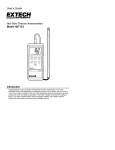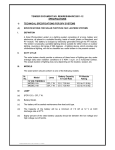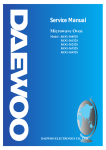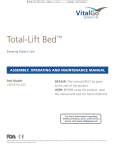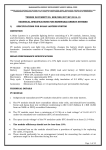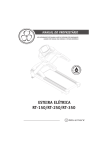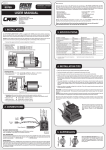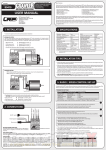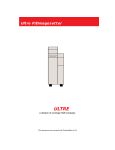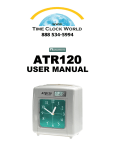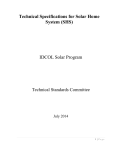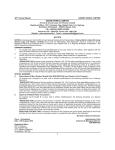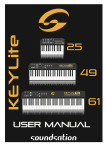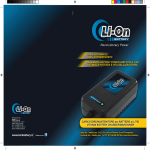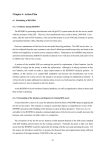Download 1 SPECIFICATIONS - Maharashtra Energy Development Agency
Transcript
MAHARASHTRA ENERGY DEVELOPMENT AGENCY (MEDA), PUNE SPECIFICATIONS 1) TECHNICAL SPECIFICATIONS FOR SPV SYSTEMS A) SPECIFICATIONS FOR SOLAR PHOTOVOLTAIC LANTERN SYSTEMS I. DEFINITION A Solar Photovoltaic Lantern is a lighting system consisting of a lamp, battery and electronics, all placed in a suitable housing, made of metal, plastic or fiberglass, and PV module. The battery is charged by electricity generated through the PV module. The lantern is basically a portable lighting device suitable for either indoor or outdoor lighting, covering a full range of 360 degrees. A lighting device, which provides only unidirectional lighting, will not be classified as a solar lantern in the present context. II. DUTY CYCLE The solar lantern should provide a minimum of three hours of lighting per day under average daily solar radiation conditions of 5 Kwh / sq.m. on a horizontal surface. The actual duration of lighting may vary depending on the location, season, etc. III. MODELS The solar lantern should conform to one of the following models: Model Sr. No. 12 VOLT MODELS MODEL II-A MODEL II-B Lamp CFL 7 W CFL 7 W Battery Capacity AT C/20 Rate 12 V, 7.00 AH 12 V, 7.00 AH PV Module Rating 10.0 to 11.9 Wp 12.0 to 14.0 Wp IV. LAMP (a) (FOR 12V) - CFL 7 W (b) Battery Model (c) The battery will be sealed maintenance free lead acid type. (d) The Capacity of the battery will be a minimum of 7.0 AH at 12 V at C/20 discharge rate at 270C. (e) Eighty percent of the rated battery capacity should be between the low voltage and high voltage cut-off points. 1 MAHARASHTRA ENERGY DEVELOPMENT AGENCY (MEDA), PUNE IV. ELECTRONICS i. The inverter will be of quasi sine wave/sine wave type with a crest factor less than 1.7 and the frequency in the rage of 20-35 KHz. Half-wave operations is not acceptable. ii. The overall efficiency of the control electronics should be at least 80%. iii. No blackening or reduction in the lumen output by more than 10% should be observed after 1000 ON / OFF cycles (two minutes ON and four minutes OFF is one cycle). iv. The idle current (i.e. the current consumed when the lamp is switched OFF and no charging is in progress) should not be more than 1 ma. v. The PCB containing the electronics should be capable of solder free installation and placement. vi. Electronics should operate at 12 V or 6 V (depending upon the model) and should have temperature compensation for proper charging of the battery throughout the year. However, systems not having the temperature compensation facility would also be allowed. V) PV MODULE (i) The wattage range of the PV modules as given in III (Models) above should be at 16.40 Volts for 12 V Models (8.7 Volts for 6 V Models) under standard test conditions (STC). The open circuit voltage of the PV modules under STC should be at least 21.0 Volts for 12 V Models (11.0 Volts for 6 V Models). (ii) The module should preferably have an arrangement (stand) for mounting at optimum angle in the direction facing the sun. (iii) In case of thin film solar cell modules, the specified values refer to the power output after the initial degradation. (iv) The terminal box on the module should have a provision for opening for replacing the cable, if required. (v) A strip containing the following details should be laminated inside the module so as to be clearly visible from the front side: the a) Name of the Manufacturer or distinctive Logo. b) Model or Type No. c) Serial No. 2 MAHARASHTRA ENERGY DEVELOPMENT AGENCY (MEDA), PUNE (VI). ELECTRONICS PROTECTIONS (i) Adequate protection is to be incorporated under no load conditions (e.g. when the lamp is removed and the lantern is switched ON). (ii) Battery cut off & reconnects should be provided to protect it against overcharge and deep discharge conditions. (iii) A fuse should be provided to protect against short circuit conditions. (iv) A blocking diode, preferably a Schottky diode, should be provided as part of the lantern electronics to prevent reverse flow of current through the PV module, in case such a diode is not provided with the module itself. (v) Full protection against open circuit, accidental short circuit and reverse polarity should be provided. (VII). OTHER FEATURES (i) The lantern should be provided with 2 LED indicators: a green light to indicate charging in progress and red LED to indicate deep discharge condition of the battery. The green LED should glow only when the battery is actually being charged. (ii) A good reliable switch suitable for DC uses to be provided on the lantern. A cable at least 5 meters long should be provided for inter-connection between the module and lantern. (iii) The following details should be marked indelibly on the lantern: a) Name of the Manufacturer or Distinctive Logo b) Model Number (this refers to Models indicated in Clause III above) c) Serial Number (iv) An Operation, Instruction and Maintenance Manual in English and the local language, should be provided with the solar lantern. 1. About Photovoltaic 2. About solar lantern 3. About P.V. module 4. About CFL 5. About battery 6. Clear instructions about mounting of PV module 7. About electronics 3 MAHARASHTRA ENERGY DEVELOPMENT AGENCY (MEDA), PUNE 8. About charging and significance of indicators 9. Do's and Don'ts 10. Clear instructions on regular maintenance and trouble shooting of the lantern. 11. Name and address of the person or service Centre to be contacted in case of failure or complaint. (v) Components and part used in the solar lantern should conform to the BIS specifications, wherever such specifications are available and applicable. (vi) The PV module will be warranted for a minimum period of 10 years from the date of supply and the lantern (including the battery) will be warranted for a minimum period of five year from the date of supply. The Warranty Card to be supplied with the system must contain the details of the system supplied. The manufacturers can also provide additional information about the system and conditions of warranty as necessary. (vii) Additional features such as socket for powering another appliance such as a fan or radio may be provided along with the switch. This is however purely optional. If such features are provided, they should not interfere with the independent switching on and off of the lantern. 4 MAHARASHTRA ENERGY DEVELOPMENT AGENCY (MEDA), PUNE B) TECHNICAL SPECIFICATION OF SOLAR HOME LIGHT SYSTEM: • Definition: A Solar home system aims at providing solar electricity for operating lights and/or fan or energizing a DC operated portable TV set for specified hours of operation per day. • Technical Specifications & General Specifications: Model Model-I One Light Point Model -II Two Lights Model –III 1 Light & 1 Fan Model-IV 2 Lights & 1 Fan Model-V 4 Lights Component Specifications PV Module 1x18 W under STC Lamp 1xCFL (9W/11W) Battery 1x12V, 20AH. Tubular Plate, low maintenance type Lead Acid Battery Control electronics. Module mounting hardware, Battery box. Others Components Inter connecting wires/cables, Switches, Operation, instruction and maintenance manual. PV Module 1x37 W under STC Lamp 2xCFL (9W/11W) Battery 1x12V, 40AH. Tubular Plate, low maintenance type Lead Acid Battery. Others Control electronics. Module mounting hardware, Battery box. Components Inter connecting wires/cables, Switches, Operation, instruction and maintenance manual. PV Module 1x37 W under STC Lamp 1xCFL (9W/11W) Fan 1xDC Fan (with wattage less than 20W) Battery 1x12V, 40AH. Tubular Plate low maintenance type Lead Acid Battery. Others Control electronics. Module mounting hardware, Battery box. Components Inter connecting wires/cables, Switches, Operation, instruction and maintenance manual. PV Module 2x37 W or 1x74 W under STC Lamp 2xCFL (9W/11W) Fan 1xDC Fan (with wattage less than 20W) Battery 1x12V, 75AH. Tubular Plate low maintenance type Lead Acid Battery. Others Control electronics. Module mounting hardware, Battery box. Components Inter connecting wires/cables, Switches, Operation, instruction and maintenance manual PV Module 2x37 W or 1x74 W under STC Lamp 4xCFL (9W/11W) Battery 1x12V, 75AH. Tubular Plate, low maintenance type Lead Acid Battery. Control electronics. Module mounting hardware, Battery box. Others Components Inter connecting wires/cables, Switches, Operation, instruction and maintenance manual 5 MAHARASHTRA ENERGY DEVELOPMENT AGENCY (MEDA), PUNE 1) DUTY CYCLE: MODELS Model -I Model -II Model -III Model -IV Model -V AVERAGE HOURS OF OPERATION / DAY 1 Lamp, 3 – 4 Hours 2 Lamp, 3 – 4 Hours 1 Lamp, 1 – 2 Hours, 1 Fan --1 – 2 Hours 2 Lamp, 2 – 3 Hours, 1 Fan --2 – 3 Hours 4 Lamp, 3 – 4 Hours 2) LAMP: The lamps will be of compact fluorescent (CFL) type, either 4 – Pin or 2 – Pin types, with ratings of 9 W or 11 W. For the 4 – Pin type CFL, a suitable pre-heating circuit must be provided. The light output from the lamp will be around 700 to 900+/- 5% lumens. Also, please see (c) of 4 given below. The lamps will be housed in a weatherproof assembly suitable for indoor use, with a reflector on its back. While fixing the assembly, the lamp will be held in a base up configuration. Maximum DC current consumption for an 11W CFL at 12 V will not exceed 1 Amp. The lamps will conform to relevant BIS standards. 3) BATTERY: a) Flooded electrolyte type, positive tubular plate, low maintenance lead acid battery, conforming to relevant BIS standards. b) The battery will have a minimum rating of 12V, 20-40 or 75 Ah (at C/10) discharge rate depending on Model. c) 75% of the rated capacity of the battery will be between fully charged and load cut off conditions. 4) ELECTRONICS: a) The inverter will be of quasi sine wave/sine wave type with frequency in the rage of 20-35 KHz. Half – Wave operation is not acceptable. b) The total electronics efficiency will be at least 80%. c) No blackening or reduction in the lumen output by more than 10% will be observed after 1000 ON/OFF cycles (two minutes ON followed by four minutes OFF is one cycle). The idle current consumption will not be more than 10 mA. Electronics will operate at 12 V and will have temperature compensation for proper charging of the battery throughout the year. d) e) Necessary lengths of wires/cables and fuses will be provided. 6 MAHARASHTRA ENERGY DEVELOPMENT AGENCY (MEDA), PUNE 5) PV MODULE (S): a) The PV module (s) shall contain crystalline silicon solar cells. b) Power output of the module (s) under STC will be a minimum of 18W or 37W or 74W. In case of Model – IV & V either two modules of minimum 37 W output each or one module of 74 W output will be used. c) The operating voltage corresponding to the power output mentioned above will be 16.4 V. d) The open circuit voltage of the PV modules under STC will be at least 21.0 volts. e) The terminal box on the module will have a provision for replacing the cables, if required. f) A strip containing the following details will be laminated inside the module so as to be clearly visible from the front side: • • • • 6) Name of the Manufacturer or distinctive logo. Model or Type No. Serial No. Year of make. ELECTRONIC PROTECTION: a) Adequate protection is to be incorporated under no e. g. When the lamp is removed and the system is switched ON. load conditions. b) The system will have protection against battery overcharge and deep discharge conditions. c) Fuses will be provided to protect against short circuit conditions. d) A blocking diode preferably a Schottky type, will be provided as part of the electronics to prevent reverse flow of current through the PV module (s), in case such diode is not provided with the PV module (s). e) Full protection against open circuit, accidental short circuit and reverse polarity will be provided. 7) MECHNICAL COMPONENTS: a) Metallic frame structure (with corrosion resistance paint) to be fixed on the pole to hold the SPV module(s). The frame structure will have provision to adjust its angle of inclination to the horizontal between 0 ºand 45º, so that the module (s) can be oriented at the specified tilt angle. b) A vented, metallic / plastic / wooden box with acid proof corrosion resistance painted metallic box for outdoor use will be provided for housing the battery. 7 MAHARASHTRA ENERGY DEVELOPMENT AGENCY (MEDA), PUNE 8) OTHER FEATURES: The system will be provided with 2 LED indicators: a green light to indicate charging in progress and a red LED to indicate deep discharge condition of the battery. The green LED will glow only when the battery is actually being charged. There will be a Name Plate on the system which give: • Name of the Manufacturer or Distinctive Logo. • Serial Number. Components and parts used in solar street lighting systems will conform to the latest BIS specifications, wherever such specifications are available and applicable. The PV module (s)/systems will be warranted as per the clause given in section 7 of part – A of the Tender document. The manufacturers can also provide additional information about the system and conditions of warranty as necessary. The warranty card to be supplied with the system must contain the details of the system supplied as given below: 9) An operation, Instruction and Maintenance Manual in English and the local language will be provided with the solar street lighting system. The following minimum details must be provided in the manual: a) About Photovoltaic b) About solar street lighting system – its components and expected performance. c) About PV Module. d) About CFL e) About Battery. f) Clear instructions about erection of pole and mounting of PV module and lamp housing assembly on the pole. g) About electronics. h) About charging and significance of indicators. i) DO’s and Don’ts j) Clear instructions on regular maintenance and trouble shooting of solar street lighting system. k) Name and address of the contact person in case of non-functionality of the solar street lighting system. 8 MAHARASHTRA ENERGY DEVELOPMENT AGENCY (MEDA), PUNE C) TECHNICAL SPECIFICATION OF SOLAR STREET LIGHTING SYSTEMS: • Definition: A stand alone solar photovoltaic street lighting systems comprises a compact fluorescent lamp, lead acid battery, PV module(s), control electronics, inter-connecting wires/cables, module mounting hardware, battery box, instruction and maintenance manual. • Technical Specifications & General Specifications: 1) DUTY CYCLE: The system will be designed to automatically switch ON at dusk, operate throughout the night and automatically switch OFF at the down, under average daily insulation of 5 kWh/sq. m. on a horizontal surface 2) LAMP: (a) The lamps will be of compact fluorescent (CFL) type, either 4 – Pin or 2 – Pin types, with ratings of 11 W. For the 4 – Pin type CFL, a suitable pre-heating circuit must be provided. (b) The light output from the lamp will be around 900+/- 5% lumens. Also, please see (c) of 4 given below. (c) The lamps will be housed in a weatherproof assembly suitable for indoor use, with a reflector on its back. While fixing the assembly, the lamp will be held in a base up configuration. (d) Maximum DC current consumption for a 11W CFL at 12 V, will not exceed 1 Amp. (e) The lamps will conform to relevant BIS standards. 3) BATTERY: a) Flooded electrolyte type, positive tubular plate, low maintenance lead acid battery, conforming to relevant BIS standards. b) The battery will have a minimum rating of 12V, 75 Ah (at C/10) discharge rate. c) 75% of the rated capacity of the battery will be between fully charged and load cut off conditions. 4) Electronics: a) The inverter will be of quasi sine wave/sine wave type with frequency in the rage of 2035 KHz. Half – wave operation is not acceptable. b) The total electronics efficiency will be at least 80%. c) No blackening or reduction in the lumen output by more than 10% will be observed after 1000 ON/OFF cycles (two minutes ON followed by four minutes OFF is one cycle). 9 MAHARASHTRA ENERGY DEVELOPMENT AGENCY (MEDA), PUNE d) The idle current consumption will not be more than 10 mA. e) Electronics will operate at 12 V and will have temperature compensation for proper charging of the battery throughout the year. f) Necessary lengths of wires/cables and fuses will be provided. g) The PV module will be used to sense the ambient light level for switching ON and OFF the lamp. 5) PV MODULE (S): a) The PV module (s) shall contain crystalline silicon solar cells. b) Power output of the module (s) under STC will be a minimum of 74W. Either two modules of minimum 37 W output each or one module of 74 W output will be used. c) The operating voltage corresponding to the power output mentioned above will be 16.4 V. d) The open circuit voltage of the PV modules under STC will be at least 21.0 volts. e) The terminal box on the module will have a provision for replacing the cables, if required. f) A strip containing the following details will be laminated inside the module so as to be clearly visible from the front side: • • • • Name of the Manufacturer or distinctive logo. Model or Type No. Serial No. Year of make 6) ELECTRONIC PROTECTION: a) Adequate protection is to be incorporated under no load conditions, e.g., when the lamp is removed and the system is switched ON. b) The system will have protection against battery overcharge and deep discharge conditions. c) Fuses will be provided to protect against short circuit conditions. d) A blocking diode preferably a Schottky type, will be provided as part of the electronics to prevent reverse flow of current through the PV module (s), in case such diode is not provided with the PV module (s). e) Full protection against open circuit, accidental short circuit and reverse polarity will be provided. 7) MECHNICAL COMPONENTS: a) Metallic frame structure (with corrosion resistance paint) to be fixed on the pole to hold the SPV module(s). The frame structure will have provision to adjust its angle of inclination to the horizontal between 0 ºand 45º, so that the module (s) can be oriented at the specified tilt angle. . 10 MAHARASHTRA ENERGY DEVELOPMENT AGENCY (MEDA), PUNE b) The pole will be made of mild steel pipe with a height of 4 mtrs above the ground level after grouting and final installation. The pole will have the provision to hold the weatherproof lamp housing. It will be painted with a corrosion resistant paint. The pole along with base plate shall have suitable cement concrete foundation to assisted local worst climate condition. The base plate shall be connected with the foundation with holding down bolted. c) A vented, acid proof and corrosion resistance painted metallic box for outdoor use will be provided for housing the battery. 8) OTHER FEATURES: a) The system will be provided with 2 LED indicators: a green light to indicate charging in progress and a red LED to indicate deep discharge condition of the battery. The green LED will glow only when the battery is actually being charged. b) There will be a Name Plate on the system which give: • • Name of the Manufacturer or Distinctive Logo. Serial Number. c) Components and parts used in solar street lighting systems will conform to the latest BIS specifications, wherever such specifications are available and applicable. d) The PV module (s)/systems will be warranted as per the clause given in section 7 of part – A of the Tender document. The manufacturers can also provide additional information about the system and conditions of warranty as necessary. The warranty card to be supplied with the system must contain the details of the system supplied as given below: 9) An operation, Instruction and Maintenance Manual in English and the local language will be provided with the solar street lighting system. The following minimum details must be provided in the manual: a) About Photovoltaic b) About solar street lighting system – its components and expected performance. c) About PV Module. d) About CFL e) About Battery. f) Clear instructions about erection of pole and mounting of PV module and lamp housing assembly on the pole. g) About electronics. h) About charging and significance of indicators. i) DO’s and Don’ts. j) Clear instructions on regular maintenance and trouble shooting of solar street lighting system. k) Name and address of the contact person in case of non-functionality of the solar street lighting system. 11 MAHARASHTRA ENERGY DEVELOPMENT AGENCY (MEDA), PUNE 10) General Installation Specifications:10.1 The SPV module will be fixed on a rigid pole. The pole will of minimum 5 cm dia GI / MS pipe of medium gage with corrosion resistance paint. 10.2 Adequate space will be provided behind the PV module / array for allowing unobstructed airflow for passive cooling. 10.3 Cables of appropriate size will be utilized to keep electrical losses to a bare minimum. 10.4 The battery will locate in a dry area with proper ventilation. Care will be taken to ensure that the battery is placed with appropriate leveling on a structurally sound surface. 10.5 The control electronics will not be installed directly above the battery. All wiring will be in proper conduit or capping casing. Wire will not be hanging loose. 10.6 Any minor items which are not specifically included in the scope of supply but required for proper installation and efficient operation of the SPV systems is to be provided by the manufacturers / suppliers. 12 MAHARASHTRA ENERGY DEVELOPMENT AGENCY (MEDA), PUNE 2) Technical Specification of Solar Water Heating System Capacity & Temperature: 125 LPD to 3000 LPD and 600 C. S.No. Item and Specifications 1 Supply of collectors and stand with installation Absorber: cu-cu only. Box Aluminum (ISI Mark Only) IS 12936 2 Supply & installation of insulated storage tank with stand Material of construction Insulation with thickness of material Density of insulation Insulation cover 3 Supply control instruments with installation • Tap (Brass Tap) • Gate Valve (Brass, 1inch,ISI Mark) • Non return valve (ISI Mark) • Air release valve (ISI Mark) • Strainer (ISI Mark) 4 Capacity of cold water tank Qty. Req. (Nos./Mtrs.) As per system capacity As per system capacity Stainless steel -304 Spintex 300 rock wool 100 mm 48 kg / m3 Aluminum sheet 22 swg 1 set for each system 1 Nos. 2 Nos. 1 No 1 No 1 No As per requierment (Minimum capacity of cold water tank shall be equivalent to the capacity of the system e.g. For 125 LPD system Cold Water Tank should be of 125 liter) 5 Supply of piping G I, Class B, ISI Cold Water - 1 " User piping upto one use point. Dia 20 mm (insulated) 6 mtr for each system 30 mtr for each system 13 MAHARASHTRA ENERGY DEVELOPMENT AGENCY (MEDA), PUNE 01. ABSORBER (A) Material : Absorber shall be of Cu-Cu type only (Copper Sheet and Copper Tube) (a) Thickness of Sheet : 34 SWG (0.19 mm) minimum (b) Risers : Diameter: 12.7 mm (+ 0.5 mm) Thickness: 24 SWG (0.56 mm) (+ No limit, - 0.07 mm) (c) Header : Diameter: Minimum 25.4 mm (OD) + 0.5 mm Thickness: 0.71 mm (+ no limit -0.07 mm) Projection: 40 mm (+ 5mm) out side (Including the collector box flange thickness) * Number of fins and tubes: Nine / collector (d) Space between Riser Tubes : Maximum space between riser tubes shall be12 cm from centre to centre of the risers. The free edges at the sides should not exceed 6 cm from the centre of the extreme and riser tube. For independent fins or joints in the sheet an overlap of minimum 2 mm shall be provided. (e) Bonding between Riser and sheet: Welding may be of continuous nature inert arc spot welding type with the product of number of spots per fin and area of spots exceeding the product of length of the fin and twice the thickness of the fin for each fin. (Continuous welding) (B) Area of Absorber : (C) Header - Riser Joints : 2.0 Sq. M (+0.1 m2) including the projected area of the header. The assembly of risers with the header shall ensure not more than 5 mm tube extension inside the header. The riser shall be brazed to the header with suitable brazing alloys with or without the use of flux. Any flux used in soldering/ brazing shall be mechanically removed and neutralized with the solution of sodium carbonate to avoid corrosion problem in future. (D) Absorber Coating : Selectively coated with solar absorptive more than 0.92 and infrared emissive less than 0.20 shall be used. The coating should be stable up to 300 0C. 14 MAHARASHTRA ENERGY DEVELOPMENT AGENCY (MEDA), PUNE 02 FLAT PLATE COLLECTORS: (a) Overall Dimensions of the Collector Box : a) Length=186cm (+1cm)/212cm (+ 1 cm)/205 cm (+ 1 cm) b) Breadth=124cm (+1cm)/104cm (+ 1 cm)/ 93 cm (+ 1 cm) c) Height= 10cm (+1cm)/10 cm (+ 1 cm)/9.3 cm (+ 1 cm) (b) Collector Box Materials : Excluding glass and glass retainer (i) Aluminum : Aluminum extruded sections of size approximately 100 mm x 25 mm channel sections and of thickness 1.6 + 0.2 mm Aluminum sheet for the bottom shall be of thickness 0.71 + 0.07 mm Aluminum Sheet for entire body shall be of 1.0 mm thickness (minimum) 1.2 mm thick Aluminum angle (dimensions 25 mm x 25 mm) as a retainer for glass. (ii) Fabrication of the Box: Side Channels shall be welded by inert arc gas welding or gas brazing to ensure leak proof continuity of the joints of the box. (iii) Attachment of Bottom sheet: Bottom sheet shall be attached by riveting, spot welding or with S.S. screws and caulking of the joints with sealing paste of Zinc Oxide based or rubber based or silicon rubber based epoxy based sealing compounds. Caulking may be done on the inside joints or inside as well as outside joints or inside as well as outside joints to ensure leak proof joints. (iv) The complete aluminum box should be powder coated. 03 Testing of Riser - Header Assembly: It will be tested for leakage and strength at a minimum hydraulic / pneumatic pressure of 5 kg/cm2 for all thermos phonic systems and systems designed for operation at 2.5 kg / cm2 or below. For systems designed for operation at higher pressure, test pressure shall be twice the system design pressure. 15 MAHARASHTRA ENERGY DEVELOPMENT AGENCY (MEDA), PUNE 04 COLLECTOR BOX INSULATION: (a) Back Insulation: Insulation of R value = 1.67 m2 C /W to withstand a temperature of 2500 C should be used. Typical insulations are: Sr. No. 1. 2. 3. Trade Name Spintex 300 (Rock wool) Twig Glass wool Fibre Glass Crown White Resin bonded K (kg/m3 ) R Minimum thickness 0.029 0.033 0.028 48 48 48 1.67 1.67 1.67 50 mm 65 mm 50 mm Aluminum foil of thickness 0.016 mm + 0.005 mm shall be used for covering the back insulation. (b) Side Insulation: Resin bonded white glass wool/Rigid polyurethane/ industrial grade spintex shall be used. So as to achieve R value =1.67 m2 o C/W. Typical insulation is as given in 4 (a). The side insulation shall be 15 mm thick (minimum). Aluminum foil of thickness 0.016 mm to 0.015 mm shall be used for covering the side insulation. 05 FRONT GLAZING: 4 mm thick + 0.2 mm toughened / tempered (Hardened) glass having transitivity of 85% or more shall be used. In hilly region only toughened glass of 4mm / 5mm of transitivity 82% or more should be used. 06 HEADER FLANGES: a) 07 Brass flanges of 62 mm + 3 mm diameter and minimum thickness of 4 mm with provision for four numbers of GI or cadmium plated bolts with diameter of 5 mm - 6 mm shall be used. Flanges shall be brazed to the header and brazing tested for leakage at the test pressure. In no case crude soldered flanges shall be used. The assembly of the flanges should be at right angle to the header area to ensure proper assembly at the site of installation. GROMMET: Suitable sealing between the inlet and outlet of header and casing of the following materials shall be provided, Neoprene, EPDM, Silicon Rubber and Butyl Rubber. 16 MAHARASHTRA ENERGY DEVELOPMENT AGENCY (MEDA), PUNE The grommet shall be suitable for a temperature upto 150oC and mechanical loading during transportation of collectors. Typical size of grommet may be 40 mm outer dia. and 25 mm inner dia. 08 ASSEMBLIES OF COLLECTORS: The load of the absorber should not be on the insulation. It should be taken by the collector box. The air gap between the glazing and the absorber should be 30 mm (+5 mm). Insulation should not be allowed to slide one of the ways is to provide extra glass wool pad below the header to clamp the back insulation pad between the header and the collector box. Glazing shall be fixed on the collector box by using EPDM channels /sponge rubber strips both at the top and bottom of the glass. The glass should be firmly held, without strain, taking into account the expansion of glass. A typical while fixing the screws on the top of the box example is by retaining the glazing with the help of stainless steel screws and aluminum angle retainer of dimensions 25 mm x 25 mm x 1.6 mm fixed on the top of the box it shall be ensured that the screws are not touching the glass edge. Top surface along the edge between the glass and the aluminum angle shall be sealed with suitable sealants such as zinc oxide based / rubber based / silicon rubber based and polysulphide rubber sealants. 09 GASKET FOR FLANGES: 3 mm thick compressed asbestos fiber gasket or Neoprene rubber gasket shall be used for sealing the joints between flanges. 10 COLLECTOR SUPPORT FRAME: The structure should be in a position to withstand a wind velocity of 100 Kms /Hr. A typical way to do this is that it shall be made with angle iron stronger than 35 mm x 35 mm x 3 mm and shall have vertical support at top and bottom edge of the inclined plane of the collector at a distance of 2.5 m or less. The vertical support shall be firmly grouted to the roof in the ground in case of ground mounted system. The grouting blocks shall be of minimum equal to 25 cm x 25 cm x 15 cm and finished properly. In case the grouting is carried out on a roof already water proofed with asphalt the back support of the collectors may be anckled to the parapet or the size of the grouting block shall be increased to provide for a dead weight anchoring of 75 Kg per leg of the vertical support. Other alternative may be got approved from Director General, MEDA, Pune. 17 MAHARASHTRA ENERGY DEVELOPMENT AGENCY (MEDA), PUNE 11 PAINTING OF STANDS: Proper cleaning and degreasing of the surface should be done before painting. Two coats of zinc chromatic red oxide primer shall be applied followed by one coat of enamel paint of suitable colour. For coastal areas and areas of sulphuric fumes and chlorides suitable anti-corrosion paints like polyurethane paint or epoxy paint should be applied after proper treatment in shop. The manufacturer may use Zinc plated stand as it has longer life. 12 STORAGE TANK (A) Material: The tank shall be made up of stainless steel. The storage tank for 100/ 200 liters capacity shall be made of 22 SWG stainless steel only. Copper tank of thickness 20 SWG may also be used. However, proper precautions shall be taken in case of higher heads. Between 200 to 500 liters capacity the storage tank shall be of stainless steel of thickness 20 SWG, for 500 - 1500 liters, it shall be of 16 SWG, for 1600 - 4500 liters, it shall be of 14 SWG and for capacity more than 4500 liters it shall be of 10 SWG thickness or more with proper stiffening. As regards support structure for the hot water and cold water is concerned ISMC 75 X 40 channels shall be used. 18 MAHARASHTRA ENERGY DEVELOPMENT AGENCY (MEDA), PUNE (B) Insulation: Insulation of R value = 3.34 m2 oC/W. to withstanding a temperature of 100 oC. Should be used. Typical insulations are:Sr. No 1. 2. 3. Trade Name Spintex - 300 Twinga Glass Wool Fiber Glass Grown White K (W/ mk) 0.029 0.033 0.028 Density (kg/m3 ) 48 48 48 R 3.34 3.34 3.34 Minimum thickness 100 mm 130 mm 100 mm Rockwool insulation with the same density will be permitted for the use. Thin polythene sheet shall be used as covering between the glass wool and the cladding sheet besides the retaining material such as chicken mesh etc. 13 PIPING: (A) Material: Medium class (B class) GI as per IS 1239 shall be used for piping. Brand for piping to be used must be of ISI mark only. (B) Insulation: Insulation of R = 1.67 m2 Deg. C./W to withstand a temp. of 1000 C. shall be used. Typical insulation are as given below, Sr. No 1. 2. 3. Trade Name Spintex 300 (Rockwool) Twiga Glass wool Fiber Glass Crown White Resin bonded K (kg/m3 ) R 0.029 0.033 0.028 48 48 48 1.67 1.67 1.67 Minimum thickness 50 mm 65 mm 50 mm The Manufacturer can also use PUF insulation of 25 mm for all water heating system pipeline and for hot water tank Puff insulation is of 50 mm. Thin plastic sheet shall be used as covering between glass wool and aluminum cladding besides other retaining material 26 SWG aluminum sheet shall be used for cladding the insulated pipe. 14 VALVES / NIPPLES / TEES / BENDS: Gunmetal valve as per ISI specification shall be used. Nipple/Tees and bends shall be of medium class GI (B class). Gunmetal valve in each row shall be provided. Air vents in each row are to be provided. Valve should be of chrome plated 900rotation ball valve should be used having standard brand. 19 MAHARASHTRA ENERGY DEVELOPMENT AGENCY (MEDA), PUNE 15 Those items, which are exposed to the air and likely to be corroded, therefore should be treated with anti corrosive treatment i.e. application of epoxy painting. 16. The system shall be supplied and installed with ISI mark, Cu-Cu selectively black chrome coated only. 17. All the joints should be flanged-type / union type with proper temperature gaskets. Rubber joints will not be accepted. Bolts and nuts used in the joints should be adequately protected against corrosion. 18. All pipe lines used should be ISI marked for the hot as well as cold water should be galvanized iron class - B conforming to IS No. 1239. 19. Instrumentation control valves and other accessories should be of high quality and of ISI make with high reliability. 20. All metal parts which are likely to get corroded should be protected by suitable paints. 21. The whole assembly shall be tested hydrolytically to withstand a pressure of 5 kg / sq.cm. 22. All installations including collectors and pipelines are to be supported ion suitable permanent metal structural supports designed for the purpose and grouted / bolted properly. 23. Civil Engineering work or construction work of any kind shall be carried out by the Contractor. 24. Angle of repose for collector should be latitude plus 150 , facing south with no shadow on neighboring collector rows. 25. All pipe lines carrying hot water above ambient temperature should be insulated with fiber rock wool / mineral wool 50 mm thick with thermal conductivity less than 0.04 K cal/hr-m degree C. or polyurethane of equivalent thickness. Hot water tank should be insulated with 100 mm thick rock wool / mineral wool. 26. The system should be painted with anticorrosive paint. One coat of primer and two final coats should be applied. 20 MAHARASHTRA ENERGY DEVELOPMENT AGENCY (MEDA), PUNE 27. Scope of work: a. Design of the system. b. Fabrication, supply and installation of suitable flat plate collectors. c. Design, fabrication, supply and the installation of suitable support for the collectors, pipes, vales and other components and accessories. d. Design, supply, fabrication, installation of cold water tank and insulated storage tank, cold water piping, insulated user piping. e. Supply and installation of control instrumentation required for the system. f. Civil work (grouting) of collectors, collector stands and tank. h. Hydraulic testing and commissioning of the system. i. Any additional works not covered above. j. Supply of manual for Operation and Maintenance to the Maintenance department of concerned beneficiary institute. k. Commissioning of the entire system. l. Training to the user for operation and maintenance of the system. 21 MAHARASHTRA ENERGY DEVELOPMENT AGENCY (MEDA), PUNE 3) Technical Specification of Wind Solar Hybrid System 1 kW TECHNICAL SPECIFICATIONS Sr. No. 1 Components and Specifications Quantity Capacity Make Generator Weight Voltage Controller Over speed protection 400W Southwest Wind power, Arizona, USA/ Any other approved and tested Airx400 10/25 400 Watts at 12.5 m/s 55 m/s 500 3.1 (m/s) 46” Injection molded carbon reinforced-2 Nos. Permanent Magnet Type 6 Kgs. Auto charge regulator Manual and automatic braking No. of machines 1 No. Model Rated wind speed (m/s / kmph) Peak Power Survival wind speed R.P.M. (Max.) Start Generating Wind Speed Rotor Diameter Propeller Material & No. of Blades 2 3 4 5 Tower Type Material of construction Finish Tower height from ground Battery Bank Type of batteries Capacity Make Inverter Capacity Type Input voltage Make Efficiency SOLAR PV PANELS Capacity 600 watts Make TATA BP/ TITAN / BHEL/ Peak Power per module 75 Watts. / 100 Watts Piped with supporting guy wires M.S. Duly epoxy coated 18 mtrs Deep Cycle Tubular 12V/300 AH HBL / Exide/ Equivalent 12 V / 0.5 kVA Sine Wave 12 V Sukam / Equivalent 90% minimum 22 MAHARASHTRA ENERGY DEVELOPMENT AGENCY (MEDA), PUNE Dimension W * H * D For 75Wp module 965 * 635 * 36 mm For 100Wp module 1295*650*36mm Temperature - 40 to +90 degree Wind Load up to 200Kmph Humidity 0 to 100% No. of S.P.V. Modules 6 Nos. of 100Wp/Equivalent SPV Support structure M.S. Angle 6 Power Centre for Aero generator consisting of Rectifier. Regulator charger, Solid State Passive Cooling constant voltage charging, fully automatic operation having display battery voltage and charging status and charge controller, Circuit Breakers, Manual break switch, non-critical load segregation. 7 Cabling from SPV Modules to power centre including inter connection ISI Standard of appropriate sizing. 8 Cabling from WEG top to Power Centre ISI Standard of appropriate sizing 9 Support structure for Solar PV panels M.S. with Anticorrosive, U.V. protective epoxy based cost. 10 Instrumentation for power measure Energy Meter Amp. Meter. Volt Meter. 11 Instrumentation for wind & solar measurement Anemometer 12 Transportation 13 System Design, Erection and commissioning 14 Civil Work RCC Construction. 23 MAHARASHTRA ENERGY DEVELOPMENT AGENCY (MEDA), PUNE 4) SPECIFICATIONS FOR SPV WATER PUMPING SYSTEMS A) SPECIFICATIONS FOR SPV WATER PUMPING SYSTEMS FOR CAPACITY OF H.P. (SPV Pump) (900 WATT PV Module) I. 1 DEFINITION A solar Photovoltaic water pumping system consist of a DC / AC surface mounted / submersible / floating motor, pump set, electronics if any, interconnect cables, a On-Off switch and a PV array mounted on a suitable structure with a provision of tracking. Storage batteries will not constitute a part of the SPV water pumping system. II DUTY CYCLE The solar PV water pumping system should provide a minimum of 77 liters of water per watt of PV array used per day under average daily solar radiation conditions of 5.5 Kwh/sq.m. on a horizontal surface, from a total head of 10 meters (suction head up to a maximum of 7 meters). In case of deep well submersible pumps, the water requirement should be a minimum of 25 liters of water per watt of PV array capacity used per day from a total depth of 30 meters. Use of a tracking system to enhance the availability of solar radiation to lift desired quantity of water is permitted. The manufacturer of SPV water pumping system is required to specify whether the minimum water out put is achieved directly or though tracking of PV array. The actual duration of pumping of water on a particular day and the quantity of water pumped may vary depending on the location, season etc. III PV ARRAY CAPACITY The SPV water pumping system should be operated with a PV array in the range of 900 watts 1800 watts, measured under standard test conditions. Sufficient number of modules in series and parallel will be used to obtain the required PV array current, voltage and power output. The power output of individual PV modules used in the PV array, under STC, should be a minimum of 37 Watts. Use of PV modules with higher power output is encouraged. In case of thin film solar cell modules, the specified values of output power refer to the power output achieved after the initial degradation. IV MOTOR PUMP-SET Type of motor pump sets are permitted to be used in the SPV water pumping systems: Surface mounted DC motor pump-set. DC Submersible motor pump set. AC Submersible motor pump set. DC floating motor pump set. Any other type of motor pump set after approval from MNRE. 24 MAHARASHTRA ENERGY DEVELOPMENT AGENCY (MEDA), PUNE The overall efficiency of the motor pump set at 10 meter total head should be at least 40 % and the efficiency of the submersible motor pump set should not be less than 35%. The manufacturer of the PV pumping system will submit a declaration that the PV array size has been selected for optimal matching with the motor-pump set to give the desired water out put performance. They will also report the over all efficiency of the motor-pump set used by them. MOUNTING STRUCTURES & TRACKING SYSTEM: To enhance the performance of SPV water pumping systems covered under the programme, it is desirable to use a tracking system. Manual, passive and electronic tracking are permitted. The PV modules will be mounted on metallic structures of adequate strength and appropriate design, which can withstand load of modules and high wind velocities up to 200 km per hour. The support structure used in the pumping system will be hot dip galvanized. V. PROTECTIONS Adequate protections should be incorporated against dry operation of motor pump set, protection against lightning and hails & storms. Full protection against open circuit, accidental short circuit and reverse polarity should be provided. VI. OTHER FEATURES (i) A good reliable switch suitable for DC /AC use is to be provided with the motor pump set. Sufficient length of cable should be provided for interconnection between the PV array and the motor pump set. The following details should be marked indelibly on the motor pump set and the photovoltaic modules: 1) 2) 3) 4) Name of the Manufacturer or Distinctive Logo. Model Number Serial Number/ Year of Manufacturing (ii) An Operation, Instruction and Maintenance Manual, in English and the local language, should be provided with the solar PV pumping system. The following minimum details must be provided in the Manual. (a) About photovoltaic (b) About solar pump (c) About PV module (d) About motor pump set (e) About tracking system (f) Clear instructions about mounting of PV module. (g) About electronics, if any 25 MAHARASHTRA ENERGY DEVELOPMENT AGENCY (MEDA), PUNE (h) (i) DO’s and DON’Ts Clear instructions on regular maintenance and trouble shooting of the pumping system. (j) Name & address of the person or Center to be contacted in case of failure or complaint. (ii) Components and parts used in the solar pumping system should conform to the BIS specifications, wherever such specifications are available and applicable. (iv) The PV modules will be warranted for a minimum period of 10 years from the date of supply and the complete SPV water pumping system will be warranted for a minimum period of two years from the date of installation. 26 MAHARASHTRA ENERGY DEVELOPMENT AGENCY (MEDA), PUNE B) SPECIFICATIONS FOR SPV WATER PUMPING SYSTEMS FOR CAPACITY OF 2 H.P. (SPV Pump) (1800 WATT PV Module) DEFINITION: A solar photovoltaic water pumping system consist of a DC/AC surface mounted/ submersible/floating motor pump set, electronics if any, interconnect cables, a On-Off switch and a PV array mounted on a suitable structure with a provision of tracking. Storage batteries will not constitute a part of the SPV water pumping system. DUTY CYCLE: The solar PV water pumping system should provide a minimum of 77 liters of water per watt of PV array used per day under average daily solar radiation conditions of 5.5 KWh/sq.m. on a horizontal surface, from a total head of 10 meters (Suction head up to a maximum of 7 meters). In case of deep well submersible pumps, the water requirement should be a minimum of 25 liters of water per watt of PV array capacity used per day from a total depth of 30 meters. Use of a tracking system to enhance the availability of solar radiation to lift desired quantity of water is permitted. The manufacturer of SPV water pumping system is required to specify whether the minimum water out put is achieved directly or though tracking of PV array. The actual duration of pumping of water on a particular day and the quantity of water pumped may vary depending on the location, season, etc. PV ARRAY CAPACITY: The SPV water-pumping system should be operated with a PV array in the range of 200 watts - 3,000 watts, measured under standard test conditions. Sufficient number of modules in series and parallel will be used to obtain the required PV array current, voltage and power output. The power output of individual PV modules used in the PV array, under STC, should be a minimum of 75 Watts, with adequate provision for measurement tolerances. Use of PV modules with higher power output is encouraged. In case of thin film solar cell modules, the specified values of output power refer to the power output achieved after the initial degradation MOTOR PUMP-SET: Following types of motor pump sets are permitted to be used in the SPV water pumping systems: Surface mounted DC motor pump-set DC Submersible motor pump set AC Submersible motor pump set DC floating motor pump set Any other type of motor pump set after approval from MNRE 27 MAHARASHTRA ENERGY DEVELOPMENT AGENCY (MEDA), PUNE The overall efficiency of the motor pump set at 10 meter total head should be at least 40 % and the efficiency of the submersible motor pump set should not be less than 35%. The manufacturer of the PV pumping system will submit a declaration that the PV array size has been selected for optimal matching with the motor-pump set to give the desired water out put performance. They will also report the over all efficiency of the motor-pump set used by them. MOUNTING STRUCTURES & TRACKING SYSTEM: To enhance the performance of SPV water pumping systems covered under the programme, it is desirable to use a tracking system. Manual, passive and electronic tracking are permitted. The PV modules will be mounted on metallic structures of adequate strength and appropriate design, which can withstand load of modules and high wind velocities up to 200 km per hour. The support structure used in the pumping system will be hot dip galvanized. PROTECTIONS: Adequate protections should be incorporated against dry operation of motor pump set, protection against lightning, hails & storms. Full protection against open circuit, accidental short circuit and reverse polarity should be provided. OTHER FEATURES: (i) A good reliable switch suitable for DC / AC use is to be provided with the motor pump set. Sufficient length of cable should be provided for inter-connection between the PV array and the motor pump set. (ii) The following details should be marked indelibly on the motor pump set and the photovoltaic modules: (a) (b) (c) Name of the Manufacturer or Distinctive Logo. Model Number. Serial Number. (iii) An Operation, Instruction and Maintenance Manual, in English and the local language, should be provided with the solar PV pumping system. The following minimum details must be provided in the Manual: (a) (b) (c) (d) (e) (f) (g) (h) (i) (j) About Photovoltaic About solar pump About PV module About motor pump set About tracking system Clear instructions about mounting of PV module. About electronics used in AC motor pump sets, if any DO's and Don’ts, Clear instructions on regular maintenance and trouble shooting of the pumping system. Name & address of the person or Center to be contacted in case of failure or complaint. 28 MAHARASHTRA ENERGY DEVELOPMENT AGENCY (MEDA), PUNE (iv) Components and parts used in the solar pumping system including the metallic structures should conform to the BIS specifications, wherever such specifications are available and applicable. (v) The PV module (s) will be warranted for a minimum period of 10 years from the date of supply and the complete SPV water pumping system will be warranted far a minimum period of two years from the date of installation. The Warranty Card to be supplied by the manufacturers with the system must contain the serial numbers of PV modules, motor pump set, electronics if any and the relevant dates about validity of warranty. The full name and address of contact person(s) for after sales service and warranty obligations must also be stated on the warranty card. A copy of warranty card will be provided to MEDA. The manufacturer can also provide additional information about the system and conditions of warranty as necessary. To ensure compliance of MNRE specifications, copies of data sheets of the PV modules, motor pump set, system design calculations, installation and O&M manuals and blank warranty cards, pass book for maintaining maintenance records etc. will be supplied by the manufacturers to User / MEDA. A copy of the drawing of the support structure will also be provided to User / MEDA. 29 MAHARASHTRA ENERGY DEVELOPMENT AGENCY (MEDA), PUNE 5) Technical Specifications for supply and installation of colour TV The Manufacturers have to supply Photovoltaic Color TV with following technical specifications: i) ii) iii) iv) v) vi) vii) 150 Watt Peak PV Module Solar panel frame with provision for tracking. 230 VAC, 52 CM screen color TV- 1 No., Make: Standard Charge controller – 1 No. Inverter - 220 VA. Battery - 12 V, 150 AH. Make: Exide/Any approved Running hours - 4 per day. 6) Solar Educational Kit Solar Education Kit has minimum 5 watt capacity solar panel and which demonstrates the various applications and working procedures of photovoltaic devices such as conversion of solar energy into electrical, mechanical, electromagnetic, sound energy, Heat Energy by the way of demonstrating working of LED light, Motor, Relay, Alarm bell , Resistance Heating. This is used to create awareness amongst students about various applications of Solar Energy. The knowledge of different type of electronic circuits is spread through the educational kit, which activates the electronic circuit using solar energy. It contains Analog Voltmeter and Ammeter for measurement purpose. Solar Education Kit must be handy and supplied with User Manual. 7) SOLAR DESALINATION SYSTEM (Solar Still) Capacity of the system Type Size Material Thickness of body Glass thickness Transtimitivity of Glass Support Stand duly painted Plastic cane Rubber/Plastic tube - Output capacity - 3 Lpd Portable 1X1m Fibre Reinforced Plastic 3 mm. 4 mm. Toughened glass 0.85 M.S. 25X 25X3 mm. 5 liter capacity Suitable size and length to connect till with plastic cane 2 – 3 Lpd 30 MAHARASHTRA ENERGY DEVELOPMENT AGENCY (MEDA), PUNE 8) Technical specifications of Solar Dryer: Sr. No. 1. Technical Conditions Type: Manufacturing, supply, installation & commissioning of solar dryer of 5 kg per day drying capacity per day for drying agriculture product i.e. Potato, Onion, spinach, Amla, Chilly etc. in the state of Maharashtra. 2. Solar dryer shall of MS / Fibre Reinforced Plastic or equivalent material 3. Tray shall be of wooden with stainless steel net or of complete stainless steel material 4. Top cover shall be of 4 mm thick. Toughened glass having transsmitivity of minimum 85 percent 5. Support stand shall be of M.S. of required size 31 MAHARASHTRA ENERGY DEVELOPMENT AGENCY (MEDA), PUNE 32
































